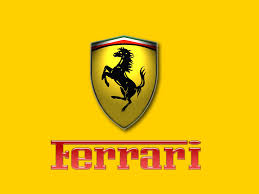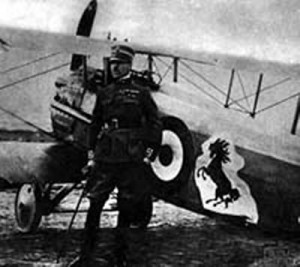|
Piaggio Aero Industries delivered an Avanti P180 executive turboprop to Ferrari on May 18, 2000. In a ceremony that took place at Piaggio Aero’s headquarters, Luca Cordero di Montezemolo, president and CEO of Ferrari, took delivery of the aircraft.
The Piaggio Avanti P180 bears the Ferrari prancing horse motif that Enzo Ferrari, born in 1898 in Modena, Italy, began using as his official symbol in the 1920s. Ferrari began working for CMN (Costruzioni Meccaniche Nazionali) in Milan in his late teens as a race car driver and test driver. He entered his first race in 1919 when he took part in the Parma-Berceto race. While racing for Alfa Romeo in 1920, he came in second in the Targa Florio. In 1923, Ferrari won his first Savio circuit in Ravenna. A meeting at that time with Count Enrico Baracca, the father of Italian World War I Ace of Aces Francesco Baracca, would lead to the well-known Ferrari emblem. |
Francesco Baracca shot down his first enemy aircraft on April 7, 1916, while flying a Nieuport II. Baracca’s aircraft bore an easily recognizable rearing black horse painted on the fuselage. He had 34 victories when he was shot down by ground fire while strafing enemy lines on June 19, 1918, in his Spad S.VII.
Later, the ace’s mother, Countess Paolina, asked Ferrari if he would put her son’s prancing horse on his cars for luck.
Ferrari used what would become known as the Ferrari Stables emblem, with its canary yellow background (chosen by Ferrari since it is the “color of Modena”) for the first time in 1929. It adorned all company publications, signage and official papers of Scuderia Ferrari, formed in Modena to organize racing for its members.
The emblem appeared on a Scuderia Ferrari team car for the first time at the Spa 24 Hours, held July 9 and 10, 1932; that car won the event. The shield thereafter adorned all the official Ferrari team cars until Scuderia Ferrari began effectively operating as Alfa’s racing division, in 1933, with Ferrari as director.
In the late 1930s, Alfa Romeo went back to running its own racing activities and set up its own racing division, Alfa Corse. Scuderia Ferrari became an independent company, Auto Avio Costruzioni Ferrari, in September 1939. Due to a severance agreement and non-compete terms of four years, the company began manufacturing machine tools.
In 1943, during World War II, the Ferrari workshop moved from Modena to Maranello, where it continued to construct oleo dynamic grinding machines until 1944, when the factory was bombed. The workshop was rebuilt in 1946, and the company began designing and building the 125 Sport.
When Franco Cortese drove the 12-cylinder, 1500 cc car on the Piacenza circuit on May 11, 1947, it sported on its bonnet an emblem bearing the prancing horse, designed by the Ferrari Technical department and produced by Castelli e Gerosa of Milan and Cristiglio of Bologna. Although the car did not win that race, it won the Rome Grand Prix two weeks later.
The Ferrari emblem remained unchanged until 1950. In 1952, Enzo Ferrari brought back the racing badge of the old Ferrari team, modernized and stylized, to distinguish the official cars from those of their customers.
Since then the symbol has been applied, with occasional exceptions, on all Ferrari cars of any category entered in races by the “competitor Ferrari.”















